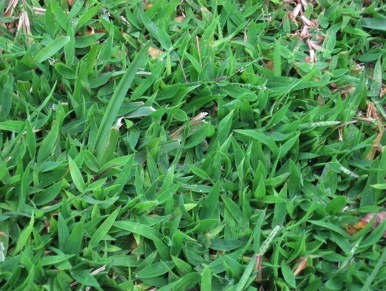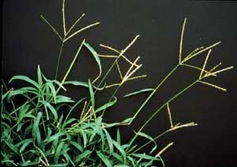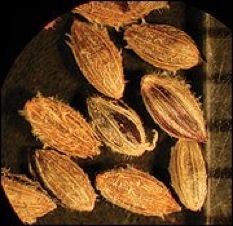Forage, Grain, Flour, Manna, Pest
Americans did two interesting things when they moved from the farm to suburbia: They surrounded their homes with toxic ornamentals and attacked edible plants as if they were life threatening.
Still on that list of dreaded home invaders is crabgrass. It would be difficult among the decapitated grass crowd to find a more hated grass than crabgrass. Multi-millions of dollars are spend annually trying to chemically choke it to death; uncounted hours are spend on hands and knees yanking it from yards. Air is polluted with crabgrass-inspired profanity. One of my neighbors spends the majority of her warm-weather weekends pulling crabgrass (which my little plot replenishes!) Even the name suggests a loathsome disease: Your lawn has the crabs. My solution? Eat the weeds.
Let’s start with a basic question: Why do lawn folks hate crabgrass? Two main reasons: Visually it does not look like the other common lawn grasses so a patch of it stands out. Next, it does not grow consistently all season so a lawn with crabgrass can look patchy. It looks good in the warm months but can grow ratty in the winter in warm climes. That is, of course, presuming you have a lawn and care what it looks like. I don’t try to keep up with the DuPonts or put their chemicals on what little lawn I have.
Adding to the manicured mania is the fact crabgrass can produce some 150,000 seeds per plant. Nature plays hardball. Said another way, lawn grass is weak and crabgrass is strong and if folks didn’t constantly fight crabgrass it would win. For that matter, the trees would win over grass but grass has enlisted humans in its war against trees so we keep the trees at bay as well. Lawn grass survives because it has made human allies. For an audio editorial on that click here.
While we try to get rid of crabgrass in America in parts of Africa crabgrass (fonio) is a staple grain, and as forage it can produce a whopping 17 tons per acre. Crabgrass seed can be used as a flour, couscous or as a grain, such as in porridge or fermented for use in beer making. Now that’s a label I’d like to see: Crabgrass Beer. Crabgrass is not only nutritious but one of the world’s fastest growing cereals, producing edible seeds in six to eight weeks. It grows well in dry areas with poor soils, and fantastically in watered lawns. It’s a horrible weed and a wonderful edible.
Husking the small grains can be time-consuming, however. Traditional methods include pounding in a mortar with sand then separating the grain and sand. Another method is “popping” seeds over a flame and then pounding said which produces a toasted grain. If you have a LOT of crabgrass you can even buy a crabgrass husking machine.
Stone Age dwellers in Switzerland cultivated crabgrass and it was important food crop in China by 2700 B.C. It’s a traditional food in India and Africa. It was first introduced into the U.S. in 1849 by the United States Patent Office as forage for cattle, sheep, hogs and horses. Then the Department of Agriculture was formed and it took over making crabgrass a main agricultural crop. Immigrants from eastern Europe. Poles, Czechs, Slovaks, and Hungarians also relied on the traditional grain. They called it kasha/kasza and spread it around but then corn was developed as an agricultural crop. Growers soon learned that corn and wheat could be grown just as easily and was worth more money than crabgrass. The beginning of crabgrass’ transition from valued food to hated weed was born.
Digitaria sanguinalis (dij-ih-TARE-ree-uh san-gwin-NAY-liss) means red fingers. Crabgrass grows from a rosette (kinda looks like a crab) and the older leaves and sheaths can turn red to maroon. The Dogon of Mali, who call crabgrass po, believe the supreme creator of the universe, Amma, made the entire universe by exploding one grain of crabgrass inside the “egg of the world”.
The leaves and be used to make paper, and ten percent of people tested are allergic to crabgrass. Lastly, even if one does not eat crabgrass seeds, it can be gotten rid of by mowing techniques. Chemicals are not needed. Personally, I raid my neighbors’ lawns.
Crabgrass Muffins
1 cup flour
1 cup crabgrass flour
2 teaspoons baking soda
2 teaspoons ginger (optional)
3/4 cup water
2 eggs
1 teaspoon vanilla
1/4 cup oil
1/2 cup raisins
Preheat oven to 350 degrees F. Place flours and baking soda in bowl, mix in water, eggs, vanilla and oil. Fold in raisins thoroughly Fill muffin tins 1/2 full or pour in 8 inch square baking pan.
Bake 20 to 25 minutes
Let cool and remove from pan. Makes 6 muffins
Green Deane’s “Itemized” Plant Profile
IDENTIFICATION: A mat-forming grass, rooting at the nodes. Leaves alternate, long, grass-like, some parallel veins, pointed tip, toothless, flowers tiny, stalkless, flattened along branches. Sides minute.
TIME OF YEAR: Seeds in fall, best after a frost.
ENVIRONMENT: Sandy soil, poorly tended lawns, gardens, old fields, roadside and waste places.
METHOD OF PREPARATION: Stripped off seeds can be toasted and ground into flour, use as couscous, porridge or for making beer. Untoasted it can be used like rice. Avoid any crabgrass that has purple or black mold on it.




